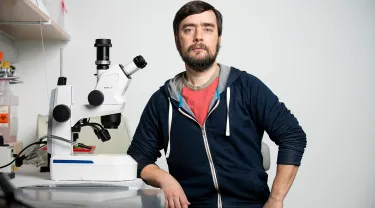For millions of patients who have lost limbs for reasons ranging from diabetes to trauma, the possibility of regaining function through natural regeneration remains out of reach. But perhaps not forever.
Adult frogs are unable to regenerate limbs naturally. But scientists at Tufts, in collaboration with colleagues at Harvard University’s Wyss Institute, were able to trigger regrowth of a lost leg on an adult frog.
“We’ll be testing how this treatment could apply to mammals next,” said Michael Levin, who is the Vannevar Bush Professor of Biology in the School of Arts and Sciences and director of the Allen Discovery Center at Tufts.
Levin runs a Tufts lab that investigates information storage and processing in biological systems in a broad range of contexts. Working on novel ways to understand and control complex pattern formation, researchers in Levin’s lab use techniques of molecular genetics, biophysics, and computational modeling to address large-scale control of growth and form.
To regrow the leg, Levin and his fellow researchers triggered the regenerative process in an African clawed frog by enclosing the wound in a silicone cap, which they call a BioDome and which contains a silk protein gel loaded with a five-drug cocktail.
Each drug fulfilled a different purpose, including tamping down inflammation, inhibiting the production of collagen in order to prevent scarring, and encouraging the new growth of nerve fibers, blood vessels, and muscle. The combination of drugs and the silicone cap provided a local environment and signals that tipped the scales away from the natural tendency to close off the stump and toward the regenerative process.
Impressively, the device needed to be applied for only 24 hours to jump-start the regeneration process. Levin and David Kaplan have created a company called Morphoceuticals to develop this work for clinical applications, starting with studying its use in mammals.
“Covering the open wound with a liquid environment under the BioDome, with the right drug cocktail, could provide the necessary first signals to set the regenerative process in motion,” Levin noted. “It’s a strategy focused on triggering dormant, inherent anatomical patterning programs, not micromanaging complex growth, since adult animals still have the information needed to make their body structures.”
Breakthroughs in regenerative medicine as illustrated by limb regeneration in the frog represent one achievement in Levin’s research portfolio. Using biophysical and computational modeling approaches, Levin’s lab seeks to understand the collective intelligence of cells, as they navigate physiological, transcriptional, morphogenetic, and behavioral spaces. Levin and his team develop conceptual frameworks for basal cognition and diverse intelligence, including synthetic organisms—including xenobots—and AI. Practical applications of their work include repair of birth defects, cancer reprogramming, and synthetic bioengineering.
